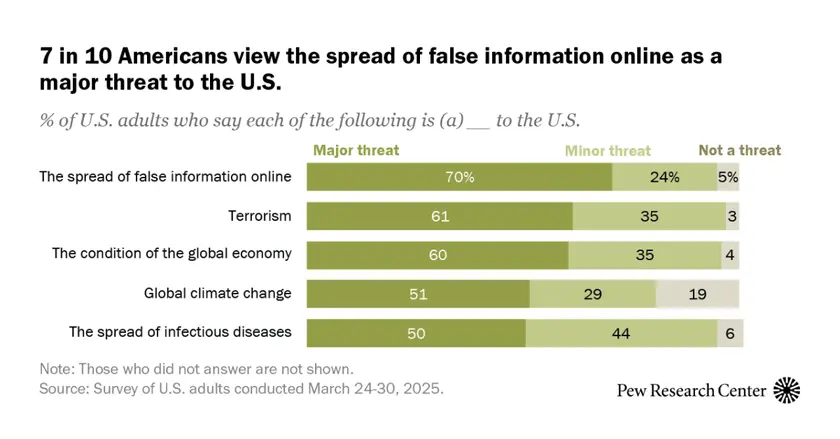T4K3.news
Global threats split by party and age
A Pew survey shows seven in ten Americans see online misinformation as a major threat, with climate and economy gaps by age and party.

A Pew Research Center survey shows dramatic differences in threat perception by political affiliation and age, with climate change and terrorism at the center of the divide.
US views of global threats vary by party and age
A Pew Research Center analysis of 3,605 U.S. adults conducted March 24 to 30, 2025 finds that seven in ten Americans view the spread of false information online as a major threat. The survey also shows that terrorism, the condition of the global economy, climate change, and the spread of infectious diseases are seen as major threats by many Americans. The results reveal clear gaps by party and by age: Democrats and younger adults express greater concern about climate change and diseases, while Republicans and older adults focus more on terrorism.
The study notes that threat perceptions have shifted since 2022, with overall declines in concern on most issues. The most notable change is a growing partisan gap in views of the global economy, while the gap on climate change remains wide. The report also compares the U.S. to other high-income countries, where climate change is viewed as a major threat at higher rates.
Key Takeaways
"Climate change is a major threat to the country"
Democrats are far more likely to rate climate change as a major threat (78%)
"Terrorism dominates concerns among older Americans"
The 65+ group reports the highest concern for terrorism (78%)
"Misinformation online threatens democracy"
Seven in ten Americans view online misinformation as a major threat
"Economic conditions divide the nation along party lines"
Democrats see the economy as a major threat more than Republicans, widening the gap
The findings reflect a persistent split in how Americans see risk, shaped by political identity and generational experience. This pattern signals that trust in institutions and media literacy will be tested as misinformation proliferates online. It also highlights how values shape what people accept as threats, from climate action to national security.
For policymakers and businesses, the message is clear: any effort to address threats must acknowledge different priorities. A one size fits all approach risks alienating voters and fueling backlash. In the long run, the divide could influence policy choices and how the public evaluates risk communication from government and platforms.
Highlights
- Climate change is a threat we cannot ignore
- Misinformation online threatens democracy
- Terrorism worries older Americans most
- Economic worries split the country along party lines
Political sensitivity and risk of backlash
The focus on partisan gaps in threat perception could fuel political backlash and misinterpretation, especially during election cycles. Readers may draw strong conclusions about one party or another based on the data.
The data points to a country learning to navigate risk in a fractured information era.
Enjoyed this? Let your friends know!
Related News

UK mandates new online safety regulations

UN chief announces shift towards renewable energy

UK public service TV endangered, says Ofcom

Vietnam sets course for economic overhaul

Gaza academics endure hunger while continuing to teach

Britons report rising concerns about global safety
Top apps face scrutiny for data tracking

Health impacts from plastics exceed $1.5 trillion annually
